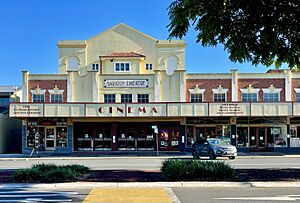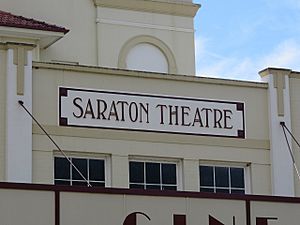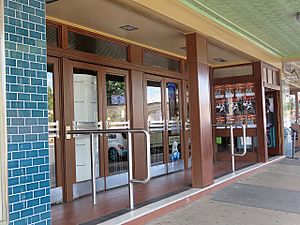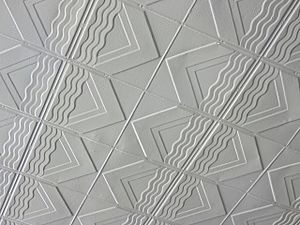Saraton Theatre facts for kids
Quick facts for kids Saraton Theatre |
|
|---|---|
 |
|
| Location | 95 Prince Street, Grafton, Clarence Valley Council, New South Wales, Australia |
| Built | 1925–1940 |
| Architect | Mr F. J. Board (1926) & Mr George Rae (1940) 1940: Mr George Rae; architect; from Brisbane |
| Owner | Notaras Bros Entertainment Pty Ltd |
| Official name: Saraton Theatre; Saraton Theatre complex including 4 shops | |
| Type | state heritage (built) |
| Designated | 9 June 2000 |
| Reference no. | 1401 |
| Type | Theatre |
| Category | Recreation and Entertainment |
| Builders | Mr. J. Walters (1926) & Goddard & Goddard (1940) 1940: Messrs Goddard & Goddard from Grafton |
| Lua error in Module:Location_map at line 420: attempt to index field 'wikibase' (a nil value). | |
The Saraton Theatre is a special old building in Grafton, Australia. It's listed as a heritage site, meaning it's important to protect its history. Today, it's a busy place where people can watch movies and enjoy live shows. The theatre was first built in 1926, designed by F. J. Board. Later, in 1940, its inside was completely updated by architect George Rae. The Notaras family has owned this theatre for a very long time. It was added to the New South Wales State Heritage Register on June 9, 2000.
Contents
The Saraton Theatre's Story
How the Theatre Began
- 1905: John Notaras came to Australia from Greece. He joined his father, who had a food shop.
- 1908: John's brother, Tony Notaras, also arrived from Greece.
- Later: The brothers opened a cafe in Grafton.
- 1926: The Saraton Theatre officially opened on July 17. The Mayor, Ald. W. T. Robinson, praised the Notaras brothers for investing in their town. He hoped it would inspire others to build new things.
Changes and Challenges Over Time
- 1932: A fire on the stage on August 20 damaged parts of the theatre, including the screen and curtains.
- 1933: Even after the fire, the theatre was used for dances and social events, not just movies.
- 1935: A new sound screen was installed, and the theatre used equipment from RCA.
- 1939: World War II started on September 3.
- 1940: The theatre's inside was completely redesigned to look very modern and luxurious. It had fancy carpets, new lighting, and beautiful curtains. The cost was almost £4000. George Rae from Brisbane was the architect. Sir Earle Page, a Member of Parliament, reopened the theatre. He said entertainment was important during wartime to keep people's spirits up.
- 1944: Another fire happened on the stage on May 10. The screen and curtains had to be replaced again.
- 1955: A new wide screen was put in for Cinemascope movies.
- 1963: Television became popular in many country areas. Around this time, the Saraton Theatre closed for a while.
- 1982: The Saraton reopened on December 10 after being repainted and refurbished.
- 1989: On January 13, a fire damaged the projection room. Movies were shown temporarily using smaller projectors. Since then, films have continued to be shown.
- 1999: The Saraton was one of only 13 country theatres still operating in New South Wales, out of 385 that existed in 1951.
Architect George Rae's Work
George Rae was a busy architect who designed about 30 movie theatres in Queensland. He also designed theatres in New South Wales towns like Murwillumbah, Casino, Cabramatta, Ballina, and Grafton. He also designed Art Deco style banks and worked on department stores.
Why the Saraton Theatre is Special
The Saraton Theatre is very important because it's one of the few old movie theatres left in New South Wales. It shows us what it was like when going to the movies was the main fun activity for most people. Back then, Australians went to the cinema about 20 times a year!
The theatre also represents how Greek immigrants helped build businesses in New South Wales. Many Greek families, like the Notaras brothers, started food businesses and then opened movie theatres in country towns. This helped them become part of their communities. The Notaras family has been involved with the Saraton for over 100 years.
Saving and Renewing the Saraton
Protecting a Piece of History
By 1999, the theatre was getting old and worn out. The Notaras family, who owned it, wanted to knock it down to build a car park. But Hazel Hawke, who was in charge of the Heritage Council of New South Wales, visited Grafton. She learned about the theatre's possible demolition and quickly put a temporary heritage order on the building. This stopped it from being torn down.
Spiro Notaras, one of the owners, later said, "She's the reason we couldn't pull it down. We cursed her for a while, but now we realise it was meant to be." The theatre received a permanent heritage order in June 2000, meaning it was officially protected.
A Big Renovation Project
The Notaras family then tried to sell the theatre to the Grafton City Council for just $1, hoping the council would fix it up. But the council said no. So, Spiro, Angelo, Mitchell, and John Notaras decided to renovate the building themselves.
They closed the theatre in 2008 for a huge, multi-year renovation. They added two smaller theatres next to the main one, seating 130 and 140 people. They also made it possible for the theatre to host live performances, not just movies. The renovation included a beautiful marble-floored foyer, a modern sound system, and more comfortable seats. The main theatre's capacity changed from 1200 to about 1050 seats. They even replaced all the plumbing and restored small details like the original bathroom signs.
After some delays, the newly renovated Saraton Theatre reopened on September 2, 2010. An official reopening was held on November 23, where they showed "Grafton at Work and Play," a silent movie that was first screened on the theatre's opening night in 1926. The renovation won a National Heritage Award in 2011. The first live show, featuring country music group The McClymonts, happened on May 7, 2011.
What the Saraton Theatre Looks Like
The Saraton Theatre building, which also includes four shops, is on Prince Street in Grafton. It's one of the few old buildings on this street that hasn't been changed too much.
The building has two main looks: the outside, which is from 1926, and the inside of the theatre, which was updated in 1940.
The Outside Look
The building is strong, made of brick with a steel roof. The stage area is lighter. Parts of the theatre, like the stairs and projection room floor, are made of reinforced concrete.
From the street, there's a unique awning that sticks out. It has deep panels that look like squares. The front of the shops and the theatre above the awning still look much like they did in 1926. Many of the original windows from 1926 are still there.
The underside of the awning has cool pressed metal designs in an Art Deco style, matching the 1940 updates. The shop fronts themselves have changed over time.
The pavement area in front of the theatre is from the 1940 renovation. The four sets of double doors from 1940 are beautiful, made of varnished wood with heavy chrome bars. Above the doors, there's a very large sign that lights up to show what movies are playing. This type of sign was popular in the late 1930s and is still used today.
The Inside Look (Before 2008-10 Renovation)
When you walked through the front doors, you entered a large, carpeted foyer. This foyer had a simple Art Deco style with buff and brown colors.
Unlike many old cinemas where stairs were hidden, the Saraton's main staircase was right in the middle of the foyer. It led up to the dress circle (the upper seating area). On either side of the stairs, there were doors to the main seating area. Along these areas were the toilets, with cool illuminated frosted glass panels above the doors showing men or women in fancy clothes from that time.
The ceiling was made of plaster with four decorative patterns, like flat ribs and fluted sections. It was painted cream. The candy bar area had been updated over the years.
The main seating area, called the auditorium, was very grand. It could originally seat 1166 people. Most of it was still original from 1940. The stage opening was about 10 meters wide, big enough for many live shows.
The 1926 design of the inside was simpler, with the roof supports showing. The 1940 architect, George Rae, cleverly covered the ceiling beneath these supports. He created a complex design of steps and patterns that looked like they were tumbling down the auditorium. This design is a great example of its kind in New South Wales.
The side walls have unique patterns of grilles that used to cover ventilation openings. These grilles have a square design with a hexagon inside. In front of the stage, there's an orchestra pit.
The dress circle, the upper seating area, is supported by columns. The front of the dress circle is one of the few parts left from the original 1926 interior. It has a slightly curved shape with pressed metal patterns of stylized plants.
Why the Saraton Theatre is a Heritage Site
The Saraton Theatre is very important because it's a rare and well-preserved example of a movie theatre from a time when going to the cinema was extremely popular. It shows how Greek immigrants helped build businesses in country New South Wales. The Notaras family has owned it for over 70 years.
It's one of only a few country theatres built before World War II that are still operating and look mostly original. Both its 1920s outside style and its late 1930s inside style give us a rare look into what the main leisure activity of that time was like.
The Saraton Theatre was listed on the New South Wales State Heritage Register on June 9, 2000, because it meets several important criteria:
- It shows how culture and history developed in New South Wales: It's important because it's linked to the huge popularity of "movie going" in the 20th century. Going to the pictures was almost as popular as sports! It influenced fashion, design, language, and behavior.
- It has a special link to important people: It has a small link to Sir Earle Page, a former Prime Minister. When he reopened the theatre in 1940, he spoke about how important entertainment was for people during wartime.
- It shows great design and creativity: The Saraton is one of the best-designed buildings from the first half of the 20th century in Grafton. It's known for both its 1926 outside and its 1940 inside design. Experts have called it "one of the most decorative and architecturally handsome in NSW."
- It has strong ties to a community or group: The Saraton shows the important role Greek immigrants played in showing films in country towns. It's possibly the last theatre still run by the family of the original Greek owners, showing over a century of the Notaras family's involvement in Grafton.
- It can teach us about history: The theatre is a physical record of how important cinema was from about 1910 to 1960. It helps young people today understand what it was like for their grandparents to go to the movies, which was the main social activity of the time.
- It's rare and endangered: The Saraton Theatre is a type of building that was once common but is now very rare. In 1951, there were 385 enclosed movie theatres in country New South Wales. By 1999, only 14 were still operating and looked original. The Saraton is one of these rare examples. Its inside design also reminds us of many Sydney suburban cinemas from the 1930s that have now been torn down.
- It shows the main features of its type of place: The Saraton clearly shows what movie theatres were like in larger country towns or busy suburbs during the 20th century, when movies were a huge cultural event.





